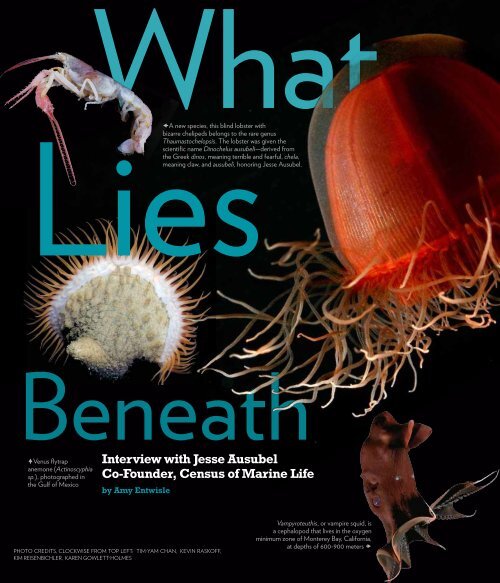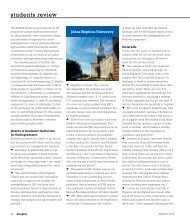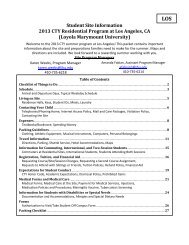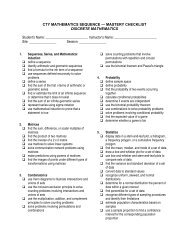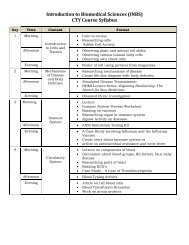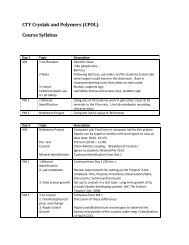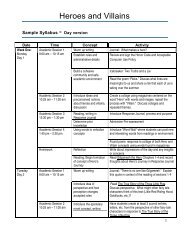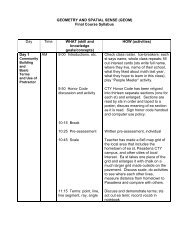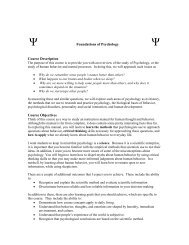Interview with Jesse Ausubel Co-Founder, Census of Marine Life
Interview with Jesse Ausubel Co-Founder, Census of Marine Life
Interview with Jesse Ausubel Co-Founder, Census of Marine Life
- No tags were found...
Create successful ePaper yourself
Turn your PDF publications into a flip-book with our unique Google optimized e-Paper software.
Whatbizarre chelipeds belongs to the rare genusThaumastochelopsis. The lobster was given thescientific name Dinochelus ausubeli—derived fromthe Greek dinos, meaning terrible and fearful, chela,meaning claw, and ausubeli, honoring <strong>Jesse</strong> <strong>Ausubel</strong>.A new species, this blind lobster <strong>with</strong>LiesBeneath•Venus flytrapanemone (Actinoscyphiasp.), photographed inthe Gulf <strong>of</strong> Mexico<strong>Interview</strong> <strong>with</strong> <strong>Jesse</strong> <strong>Ausubel</strong><strong>Co</strong>-<strong>Founder</strong>, <strong>Census</strong> <strong>of</strong> <strong>Marine</strong> <strong>Life</strong>by Amy EntwislePhoto credits, clockwise from top left: Tim-Yam Chan, Kevin Rask<strong>of</strong>f,Kim Reisenbichler, Karen Gowlett-HolmesVampyroteuthis, or vampire squid, isa cephalopod that lives in the oxygenminimum zone <strong>of</strong> Monterey Bay, California,at depths <strong>of</strong> 600-900 meters •
Crossotanorvegica, ajellyfish, collectedfrom the deepArctic CanadaBasinIn 2000, Imagine published an article aboutthe <strong>Census</strong> <strong>of</strong> <strong>Marine</strong> <strong>Life</strong> (COML), then in itsinfancy. Over the ensuing 10 years, researchersfrom over 80 countries participated in thisunprecedented scientific exploration to measureand explain the diversity, distribution, andabundance <strong>of</strong> life in the world’s oceans. Today,the COML represents the most comprehensiveinventory <strong>of</strong> marine life ever compiled: 28million records and growing. Here, <strong>Jesse</strong><strong>Ausubel</strong>—Director <strong>of</strong> the Program for HumanEnvironment at The Rockefeller University,adjunct faculty member at Woods HoleOceanographic Institution, and co-founder <strong>of</strong>the <strong>Census</strong> <strong>of</strong> <strong>Marine</strong> <strong>Life</strong>—explains why smallis really big, and why he has hope that we willpreserve the biodiversity <strong>of</strong> our oceans.Anders WarénMultilayered structure <strong>of</strong> the shell <strong>of</strong>Crysomallon squamiferum, a recentlydiscovered gastropod mollusk from theKairei Indian hydrothermal vent field.It is unlike any other known natural orsynthetic engineered armor.How did you come up <strong>with</strong> the ideafor the <strong>Census</strong> <strong>of</strong> <strong>Marine</strong> <strong>Life</strong>?In 1996, Pr<strong>of</strong>essor Fred Grassle <strong>of</strong> Rutgers University approached me<strong>with</strong> a report, published in 1995 by the National Research <strong>Co</strong>uncil,called Understanding Biodiversity. Fred served on the committee <strong>of</strong>authors, and said to me, “This was a good report, but none <strong>of</strong> therecommendations are being implemented. There’s so much to discoverand the oceans are changing very fast.” Fred said that something bigneeded to be done. I said, “Big means global. You can’t just look at theNorth Atlantic or the Caribbean. You should do a worldwide census.”I’d had experience organizing cooperative international scientificprograms, so over the course <strong>of</strong> the next hour and a half we came up<strong>with</strong> the idea <strong>of</strong> the worldwide <strong>Census</strong> <strong>of</strong> <strong>Marine</strong> <strong>Life</strong>.What were some <strong>of</strong> the first findings <strong>of</strong> the <strong>Census</strong>?Deep in the North Atlantic, in the world’s longest mountain range,is a sort <strong>of</strong> canyon called the Charlie Gibbs Fracture zone, throughwhich a lot <strong>of</strong> water passes. It had never really been explored. UsingMir submersibles—the Russian submersibles that found the Titanic—aRussian-American expedition explored the zone and discovered a tremendousamount and variety <strong>of</strong> life: amphipods, copepods, decapods,zooplankton, and new kinds <strong>of</strong> squid. That was in the summer <strong>of</strong> 2003.What’s been the biggest surprise for you so far?A huge surprise for me was the importance <strong>of</strong> very small life in theoceans, <strong>of</strong> single-cell organisms such as bacteria and archaea. Verysmall life makes up about 90 percent <strong>of</strong> all the biomass in the oceans.And we found enormous variety <strong>with</strong>in that. There might be 38,000different kinds <strong>of</strong> bacteria in a liter <strong>of</strong> sea water.The other big surprise is the amazingly cosmopolitan behavior <strong>of</strong>the large animals that connect the oceans. Bluefin tuna swim backand forth between Sicily and Cuba and between Los Angeles andYokohama. White sharks swim back and forth between Australia andSouth Africa. Some turtles circumnavigate the entire Pacific. A turtlemight set <strong>of</strong>f from a beach in Central America, go down to SouthAmerica, swim across the South Pacific over to Australia, up to thePhilippines, up to Japan, and then swing all the way back around toCalifornia and down to Central America again.Can the <strong>Census</strong> tell us anything about globalwarming and its effects on the ocean?Part <strong>of</strong> the reason for the <strong>Census</strong> is that we believe that global changesare taking place. There are changes in noise in the ocean, in acidity,probably in currents and temperature. We wanted to create a baselineso that in 2015 or 2050, we could make comparisons. But even <strong>with</strong>inwww.cty.j imagine 19
Karen Gowlett-HolmesEnric SalaA. Fifis•South <strong>of</strong> Easter Island, <strong>Census</strong> ventexplorers discovered a crab so unusual itwarranted a whole new family designation,Kiwidae, or “Yeti crab.” Beyond addinga new family to the wealth <strong>of</strong> knownbiodiversity, its discovery added a newgenus, Kiwa, named for the mythologicalPolynesian goddess <strong>of</strong> shellfish.The tube anemonelives in a mucous tube onthe muddy bottoms <strong>of</strong>coastal waters, estuaries,and s<strong>of</strong>t seabeds.Why DoesB i o d i v e r s i t yM a t t e r ?Biodiversity is a measure <strong>of</strong> thehealth <strong>of</strong> an ecosystem. A diversebiological community allows forgreater interactions among species—greatercompetition, predation,and productivity—than a non-diversecommunity. If one species’ populationdeclines, a diverse portfolio has agreater chance <strong>of</strong> adjusting to this lossthan one that is non-diverse, wherethe consequences are greater.the decade <strong>of</strong> the study, some regional teams observed changes.Our Chinese team, looking at the South China Sea and theEast China Sea, found increases in certain jellyfish populations,suggesting that the water was warming. Our Arctic teamobserved some species <strong>of</strong> animals living further north than hadbeen recorded in the past, again suggesting that some changein habitat was occurring.Animals are temperature sensitive. Some marine animals areadapted to a wide range <strong>of</strong> temperatures, but many swim northwhen the water is warmer in summer and go south when thewater is cooler, the same way that birds migrate. It’s clear thatclimate change would lead to a big reorganization <strong>of</strong> life in theoceans. It’s hard to know whether there would be a global increaseor decrease in all the life, but it’ll certainly be a big reorganization.Aside from providing a baseline, what are some<strong>of</strong> the ways in which the findings will be used?One <strong>of</strong> our goals was to create a complete world marine biodiversitydatabase. The <strong>Census</strong> has already prepared maps<strong>of</strong> hotspots <strong>of</strong> biodiversity in the world’s oceans, andthese have been shared <strong>with</strong> the UN’s international<strong>Co</strong>nvention on Biological Diversity. Recently in Nagoya,Japan, the <strong>Co</strong>nvention sought to identify what they callecologically and biologically sensitive areas, or EBSAs.One hundred ninety countries came to an agreementthat they’d like to increase the area <strong>of</strong> protected oceanfrom about one percent today to 10 percent by 2020.Ten percent may not sound like much, but a tenfoldincrease in the amount <strong>of</strong> area protected from overfishingor habitat destruction would be a tremendousstep forward. The Charlie Gibbs Fracture zone is nowprotected. Areas <strong>of</strong> the Antarctic that are especially richin marine life are tentatively designated for protection as well.Grey reef shark and blacktipshark hovering over pristine coralreef at Malden Island, SouthernLine Islands, Kiribati.The <strong>Census</strong> found that some <strong>of</strong> the same areasthat provide for great biodiversity are also vastresources <strong>of</strong> natural gas and petroleum. Doyou think it’s possible to balance our need forenergy <strong>with</strong> the need to sustain biodiversity?I think that we have to. Around the continents are shallowshelves that go to 200 meters, or about 600 feet deep. Then youhave continental margins, or continental slopes, that go downto the vast abyssal plains, which average 10,000 to 12,000 feet.These sloping areas <strong>with</strong> the gradients—think <strong>of</strong> them as hillsides—haveunexpectedly high levels <strong>of</strong> biodiversity. They also Jan/Feb 2011
The <strong>Census</strong> <strong>of</strong> <strong>Marine</strong><strong>Life</strong> found• more than 6,200 new marinespecies• up to 38,000 different kinds <strong>of</strong>bacteria in a liter <strong>of</strong> seawater• a Jurassic shrimp thought to havebecome extinct 50 million years ago• multicellular animals thriving<strong>with</strong>out oxygen at sea bottom• fish swimming in coordinated schoolsas large as Manhattan Island. Theycommute at regular hours.The Antarctic ice fish has no red blood pigments (hemoglobin) and nored blood cells, an adaptation to the low temperature. The blood becomesmore fluid, and the animal saves energy to pump blood through its body.•For more information:Download the First <strong>Census</strong> <strong>of</strong> <strong>Marine</strong><strong>Life</strong> 2010: Highlights <strong>of</strong> a Decade<strong>of</strong> Discovery, a 64-page report thatdescribes some scientific highlights <strong>of</strong>the COML, at www.coml.org.J. GuttC. Piotrhave enormous amounts <strong>of</strong> natural gas, and to a lesser extent,petroleum. Oil companies have been drilling and extractingoil and gas on the shelves for decades. In the last 10 to 15 yearsthey’ve started drilling deeper, 1,000 meters, 2,000 meters.The Brazilian national oil company Petrolbras has made hugediscoveries <strong>of</strong> gas and oil along the continental margins south<strong>of</strong> Rio de Janeiro. It’s enormously valuable, and once people findit, it rarely stays in the ground. So we have to figure out how toextract the oil and gas <strong>with</strong> minimum damage. People may lovethe oceans, but they love their mobility, too.The <strong>Census</strong> refers to one <strong>of</strong> the impedimentsto studying marine life as “blinders we put onourselves by choosing not to learn or spend.”Do you think that the public can be persuadedto support exploration <strong>of</strong> marine life?The public engagement <strong>with</strong> the <strong>Census</strong> has been wonderful,beyond our wildest expectations. We’re delighted that the yeticrab and others <strong>of</strong> our animals are now replicated as stuffedanimals, and are featured on skateboards. There has been a bigincrease in public interest in the varieties <strong>of</strong> marine life and thethreats to marine life during the last decade.A hundred years ago, Teddy Roosevelt established a system<strong>of</strong> protected lands—our national park system. It was not until1975 that the first bit <strong>of</strong> ocean was protected in the U.S., and it’sonly recently that we’ve started to seriously consider the ideathat we really need parks in the ocean. In 2006, a very largepark was created around the northwest Hawaiian Islands. Onthe basis <strong>of</strong> the <strong>Census</strong> findings, there are many more areas thatwe think are more valuable to people if they’re left alone thanif they’re exploited. We hope that the blinders are coming <strong>of</strong>f.It’s partly because <strong>of</strong> technology that we’re able to get people’sattention. We’re hoping that the discoveries <strong>of</strong> the <strong>Census</strong>—themaps it’s created, the interactive tools on the Web—will help peopleto really look at the oceans. Instead <strong>of</strong> seeing only this opaque,uniform surface, they’ll see tuna commuting underwater betweencontinents and Great Whites hanging out at the White Shark Café.They’ll think, oh, underneath there are living villages and cities,blue highways and canyons—and they’ll care more for them.You had a 10-year timetable to complete the<strong>Census</strong>. The 10 years is up. What’s next?In September <strong>of</strong> 2011 there will be a world conference onmarine biodiversity in Scotland, and many members <strong>of</strong> ourcommunity are hatching plans for what some are calling<strong>Census</strong> 2020. Some <strong>of</strong> the questions to which we’re seekinganswers are obvious: What is the relationship <strong>of</strong> marine biodiversityto global change? How might acidification, increasesin noise in the ocean, and changes in currents or temperatureaffect the diversity, distribution, and abundance <strong>of</strong> marinelife? But there’s a lot still to discover, too. There are about250,000 known forms <strong>of</strong> marine life that earn the rank <strong>of</strong> species,but we estimate that there are three-quarters <strong>of</strong> a millionforms <strong>of</strong> life yet to be discovered.• Microporellaklugei, a newspecies <strong>of</strong>bryozoan fromArctic Svalbardwww.cty.jhu.edu/imagine imagine 21


